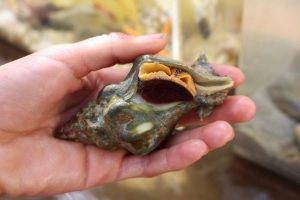
When thinking of marine predators, snails aren’t usually the first animals that come to mind. The Kellet’s whelk is a type of carnivorous sea snail that lives in the sandy bottoms and kelp forests of the California coast, and inside its beautiful spiral shell lie a host of finely-tuned predatory tools and instincts. The Kellet’s whelk is the largest whelk species in California, growing up to seven inches in length. Its life span is unknown, but some scientists speculate they could live to be up to 50 years old. It spends its days scouring for meat on the ocean floor, either by scavenging on dead animals or by hunting sea snails, clams, and crustaceans. Like many other gastropods, whelks have sensitive chemoreceptors that allow them to “taste” the water for dissolved particles, helping them find food from a distance. A dead fish carcass will often attract several whelks from all over the ocean floor.
 Kellet’s whelks hunt by using a long, muscular proboscis, which is a flexible appendage kind of like an elephant’s trunk. At the tip of the proboscis is a rough radula that acts as a file to grind away pieces of meat and shell. The Kellet’s whelk can extend its proboscis to over twice its body length, so it is able to reach food from a distance even if it lies in rock crevices that are two tight for its body to fit. If it is hunting another snail, the whelk will secrete digestive enzymes as it grinds a hole in the shell so it can suck out the body of the snail inside.
Kellet’s whelks hunt by using a long, muscular proboscis, which is a flexible appendage kind of like an elephant’s trunk. At the tip of the proboscis is a rough radula that acts as a file to grind away pieces of meat and shell. The Kellet’s whelk can extend its proboscis to over twice its body length, so it is able to reach food from a distance even if it lies in rock crevices that are two tight for its body to fit. If it is hunting another snail, the whelk will secrete digestive enzymes as it grinds a hole in the shell so it can suck out the body of the snail inside.
In recent years, a growing demand for Kellet’s whelk meat has turned it into a rising fishery, with most being taken as bycatch in lobster traps and sold to fish markets. Because the Kellet’s whelk is slow to grow and mature, they are vulnerable to being over harvested, and new research is being conducted to measure the ongoing effect that these new fishing practices will have on the whelk’s population levels.
Written by: Megan Petkovic


